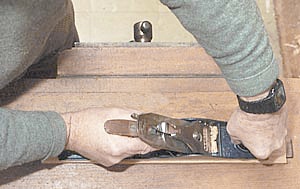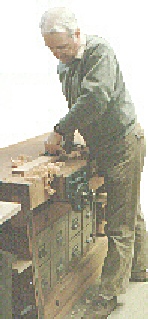

Copy the right-handed invisible man!
Stand against the bench, left foot forwards. Set your feet about 18in apart, with most of the weight on the right leg.
Place your right foot is at right angles to the bench with the left pointing half-forwards.
The bench stop is positioned so that the right shoulder can get directly over the workpiece.


Here, the plane is at mid-stroke. Note that the lower part of the left arm is as near to vertical to the bench as it will comfortably go.
The right-hand index finger lies on the side of the frog, although there is no functional need to do so. For safety, it is wise to keep both the right thumb and index finger well inboard of the plane's sides. When working longer stuff, it is quite possible to catch a thumb in a buttoned-up workshop coat.
Right:Plant the end of the job against the bench stop.
At the start of the stroke, press your left hand downwards on top of the knob so that your weight is transmitted through the ball of the thumb.
This is important because the combined overhanging weight of the plane and your right arm tends to cause the heel to droop.
The shoulder, elbow, wrist linkage is far from an ideal configuration for transmitting body weight to the knob. Lift your elbow as far as you reasonably can, and lean on the left arm.


Left:The opposite thing can happen at the end of stroke. If you are not careful you will find that you have planed a convex surface. This is less likely to happen if you aim for a scooping motion.
More of your weight should now be on the left, your trunk having moved with the plane, and the downwards pressure concentrated over the heel of the plane. For very long jobs, you will need to walk with the plane.
What about the return stroke? For small workpieces you will have to lift the plane off the wood, but on larger pieces, you can just lift the heel and drag the toe, or twist the plane sideways using the arris of the sole as a skate.
If shavings get between the sole and the wood and so stop the plane working, it might be because the plane is drawn back before the shaving is finished. Unless the blade passes the end of the workpiece, you will need to lift the plane before pulling backwards.
One mini-problem as you lift, is that as you produce a flatter and flatter surface, the wood might stick to the plane through suction, then fall and clatter on to the bench top. The soles of some planes are grooved with the intention of reducing the suction effect.